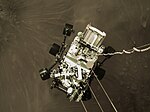KOI-5
 From Wikipedia the free encyclopedia
From Wikipedia the free encyclopedia
| Observation data Epoch J2000 Equinox | |
|---|---|
| Constellation | Cygnus |
| Right ascension | 19h 18m 57.5312s |
| Declination | +44° 38′ 50.6176″ |
| Astrometry | |
| Radial velocity (Rv) | -35.16[1] km/s |
| Proper motion (μ) | RA: 3.216[1] mas/yr Dec.: -10.925[1] mas/yr |
| Parallax (π) | 1.7436 ± 0.0666 mas[1] |
| Distance | 1,870 ± 70 ly (570 ± 20 pc) |
| Position (relative to KOI-5A)[2] | |
| Component | KOI-5B |
| Epoch of observation | 2016 |
| Angular distance | 0.029±0.050″ |
| Position angle | 142.1±1.0° |
| Projected separation | 16[citation needed] AU |
| Position (relative to KOI-5A)[2] | |
| Component | KOI-5C |
| Epoch of observation | 2016 |
| Angular distance | 0.141±0.050″ |
| Position angle | 304.3±2.2° |
| Projected separation | 78[citation needed] AU |
| Details[3] | |
| KOI-5A | |
| Mass | 1.13[4] M☉ |
| Radius | 1.840±0.017 R☉ |
| Luminosity | 3.86±0.17 L☉ |
| Surface gravity (log g) | 4.19[5] cgs |
| Temperature | 5861[5] K |
| Age | 3.49±0.41 Gyr |
| KOI-5B | |
| Mass | 1.09[4] M☉ |
| Other designations | |
TOI-1241, 2MASS J19185753+4438507, KIC 8554498, Gaia EDR3 2126945668448657664 | |
| KOI-5A: | |
| KOI-5B: | |
| Database references | |
| SIMBAD | data |
KOI-5 is a triple star system composed of three stars: KOI-5 A, KOI-5 B and KOI-5 C, orbiting 1,870±70 light-years away.
The two dim stellar companions to KOI-5A were discovered in 2016.[2] KOI-5 A and B orbit each other every 29 years, and KOI-5 C orbits stars A and B every 400 years.[4] KOI-5C is physically associated with the core stellar pair with probability 99.98%.[6]
Planetary system
[edit]Two planets orbiting one of KOI-5's stars were suspected since 2009 based on Kepler data, but KOI-5Ab was confirmed only in January 2021 after TESS determined the planet is orbiting KOI-5A. The exoplanet has caused interest in the scientific community because its orbital plane is misaligned with the closer star, suggesting it gave KOI-5Ab a gravitational kick during its development, resulting in the misalignment and inward migration to the current orbit.[4][7] However, the confirmation of this planet has yet to be published in any peer-reviewed journal.
A second candidate planet was initially suspected, but was later found to be a false positive.[8]
| Companion (in order from star) | Mass | Semimajor axis (AU) | Orbital period (days) | Eccentricity | Inclination | Radius |
|---|---|---|---|---|---|---|
| b | 0.179 MJ | 0.0596060 | 5 | — | — | 7.07 R🜨 |
References
[edit]- ^ a b c d Brown, A. G. A.; et al. (Gaia collaboration) (2021). "Gaia Early Data Release 3: Summary of the contents and survey properties". Astronomy & Astrophysics. 649: A1. arXiv:2012.01533. Bibcode:2021A&A...649A...1G. doi:10.1051/0004-6361/202039657. S2CID 227254300. (Erratum: doi:10.1051/0004-6361/202039657e). Gaia EDR3 record for this source at VizieR.
- ^ a b c Furlan, E.; Ciardi, D. R.; Everett, M. E.; Saylors, M.; Teske, J. K.; Horch, E. P.; Howell, S. B.; Van Belle, G. T.; Hirsch, L. A.; Gautier, T. N.; Adams, E. R.; Barrado, D.; Cartier, K. M. S.; Dressing, C. D.; Dupree, A. K.; Gilliland, R. L.; Lillo-Box, J.; Lucas, P. W.; Wang, J. (2017), "The Kepler Follow-Up Observation Program. I. A Catalog of Companions To Kepler Stars from High-Resolution Imaging", The Astronomical Journal, 153 (2): 71, arXiv:1612.02392, Bibcode:2017AJ....153...71F, doi:10.3847/1538-3881/153/2/71, S2CID 38339900
- ^ Bellinger, E. P.; Hekker, S.; Angelou, G. C.; Stokholm, A.; Basu, S. (2020), "Stellar ages, masses, and radii from asteroseismic modeling are robust to systematic errors in spectroscopy", Astronomy & Astrophysics, 622: A130, arXiv:1812.06979, doi:10.1051/0004-6361/201834461, S2CID 119293351
- ^ a b c d e AT LAST! CONFIRMATION OF KEPLER'S SECOND PLANETARY CANDIDATE
- ^ a b Batalha, Natalie M.; Rowe, Jason F.; Bryson, Stephen T.; Barclay, Thomas; Burke, Christopher J.; Caldwell, Douglas A.; Christiansen, Jessie L.; Mullally, Fergal; Thompson, Susan E.; Brown, Timothy M.; Dupree, Andrea K.; Fabrycky, Daniel C.; Ford, Eric B.; Fortney, Jonathan J.; Gilliland, Ronald L.; Isaacson, Howard; Latham, David W.; Marcy, Geoffrey W.; Quinn, Samuel N.; Ragozzine, Darin; Shporer, Avi; Borucki, William J.; Ciardi, David R.; Gautier, Thomas N.; Haas, Michael R.; Jenkins, Jon M.; Koch, David G.; Lissauer, Jack J.; Rapin, William; et al. (2013), "Planetary Candidates Observed by Kepler . III. Analysis of the First 16 Months of Data", The Astrophysical Journal Supplement Series, 204 (2): 24, arXiv:1202.5852, Bibcode:2013ApJS..204...24B, doi:10.1088/0067-0049/204/2/24, S2CID 19023502
- ^ a b Hirsch, Lea A.; Ciardi, David R.; Howard, Andrew W.; Everett, Mark E.; Furlan, Elise; Saylors, Mindy; Horch, Elliott P.; Howell, Steve B.; Teske, Johanna; Marcy, Geoffrey W. (2017), "Assessing the Effect of Stellar Companions from High-resolution Imaging of Kepler Objects of Interest", The Astronomical Journal, 153 (3): 117, arXiv:1701.06577, Bibcode:2017AJ....153..117H, doi:10.3847/1538-3881/153/3/117, S2CID 39321033
- ^ Chen, Rick (2021-01-11). "Planetary Sleuthing Finds Triple-Star World". NASA. Retrieved 2021-01-13.
- ^ a b "Exoplanet Archive". exoplanetarchive.ipac.caltech.edu. Retrieved 2021-07-17.


